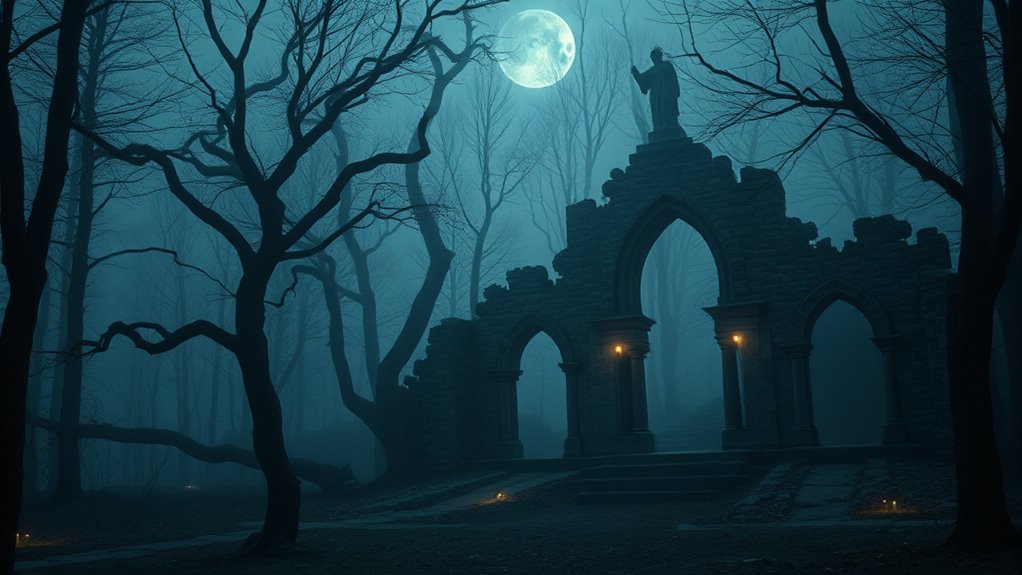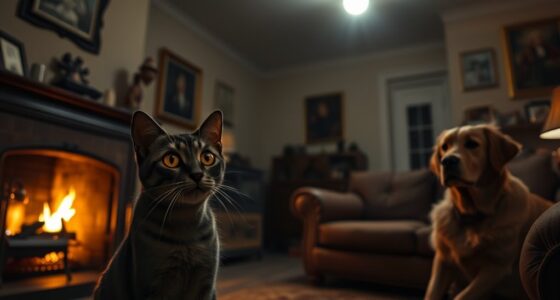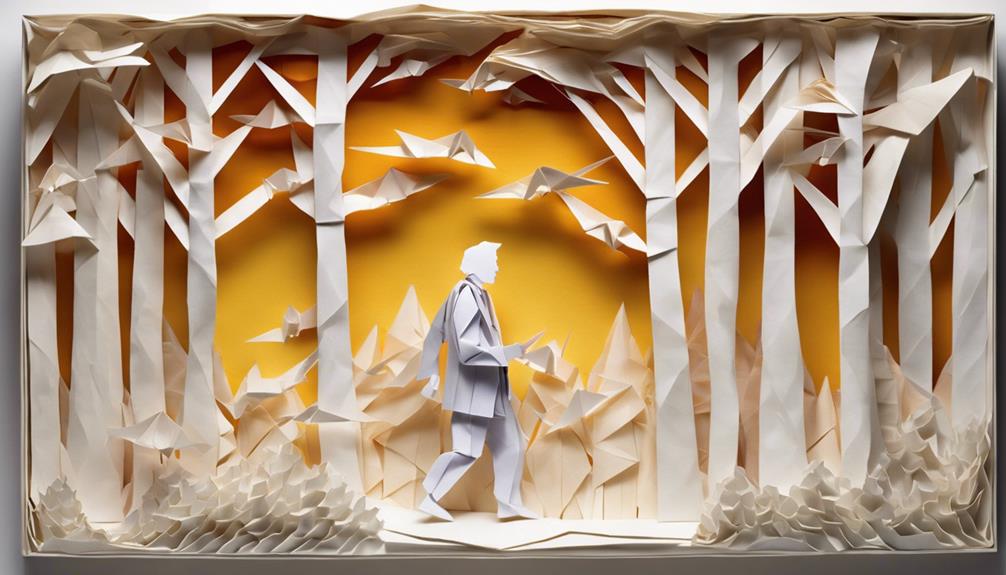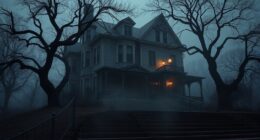Certain places feel haunted because of environmental conditions like darkness, cold spots, and eerie sounds that heighten your senses and create a spooky atmosphere. Historical events, unresolved mysteries, and local legends add to the sense of lingering energy and mystery. Media stories and cultural beliefs also influence how you perceive these sites. Combined, these factors shape your experience and perception of paranormal activity—if you want to understand more about why some spots feel truly haunted, keep exploring further.
Key Takeaways
- Environmental factors like dim lighting, temperature drops, and electromagnetic interference can distort perceptions, creating a haunted feeling.
- Historical events, unresolved mysteries, and local legends reinforce the ghostly reputation of certain locations.
- Psychological biases, such as pattern recognition and confirmation bias, influence interpretation of ambiguous stimuli as paranormal.
- Residual energy from traumatic or emotional past events can manifest as eerie sensations or unexplained phenomena.
- Media, movies, and urban legends shape collective beliefs, amplifying fears and mythologizing haunted hotspots.
The Power of Atmosphere and Environment
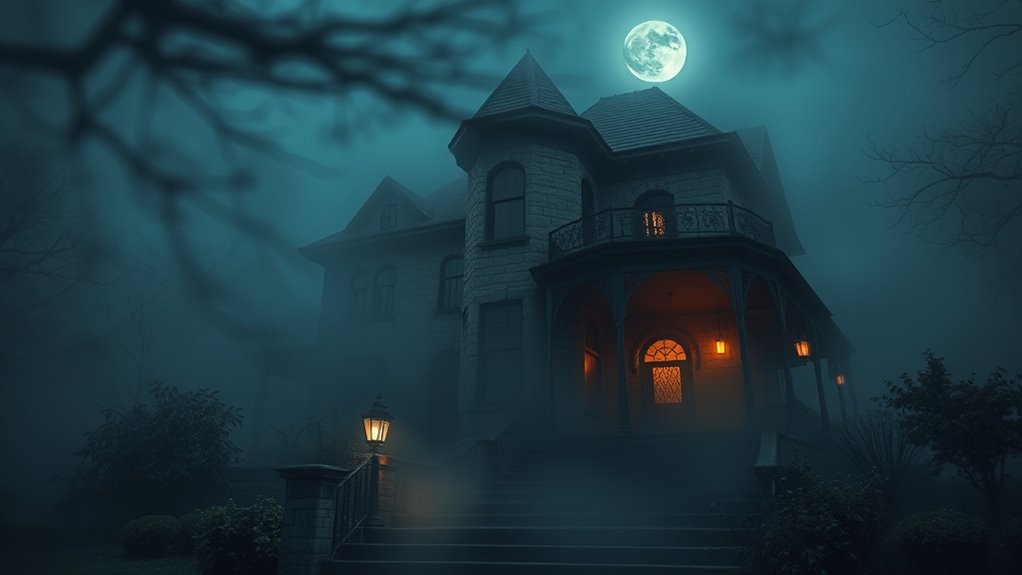
The atmosphere and environment play a crucial role in shaping ghostly hotspots, as they create the perfect conditions for paranormal activity to thrive. Atmospheric conditions like dim lighting, temperature drops, and eerie sounds heighten the sense of unease, making a location feel haunted. Environmental psychology explains how our surroundings influence perception and emotions, often amplifying feelings of fear or unease in certain spaces. These subtle cues can trigger the brain to interpret normal environmental features as supernatural phenomena. For example, atmospheric oils like eucalyptus and lavender can influence mood and perception, further intensifying these feelings. When combined, atmospheric conditions and psychological responses intensify the eerie vibe of a place, making it seem more haunted than it might actually be. Understanding this connection helps explain why some locations consistently evoke ghostly feelings, even without concrete evidence.
Historical Significance and Unresolved Mysteries
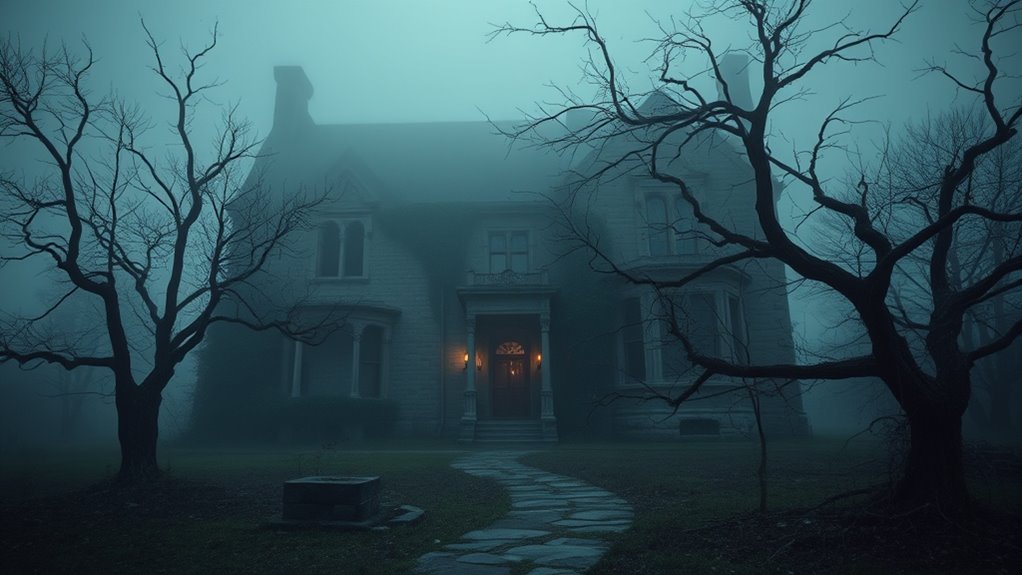
Historical significance and unresolved mysteries often turn locations into ghostly hotspots because their stories and secrets linger in the air. When a place has a rich past, it’s easy for ghostly legends to take root, fueling spectral folklore that persists across generations. These stories often involve tragic events, hidden treasures, or unresolved crimes, adding layers of intrigue and eeriness. The more unresolved the mystery, the more it invites speculation and belief in the supernatural. You might feel a chill or hear inexplicable sounds, as the ghostly legends continue to breathe life into the location. It’s this combination of history and mystery that makes some sites feel haunted, their stories echoing through time and fueling the sense of an unseen presence lingering nearby. Additionally, vetted locations with well-documented histories are more likely to develop enduring ghost stories because their narratives are rooted in factual events that continue to captivate our imagination.
The Role of Collective Memory and Cultural Beliefs

Collective memory and cultural beliefs shape how communities interpret and perpetuate ghost stories, transforming personal experiences into shared legends. These beliefs influence which places are considered haunted and how stories evolve over time. Your community’s collective memory often highlights specific events or figures, reinforcing the idea that certain locations are hotspots for spirits. To understand this, consider: 1. How cultural beliefs assign spiritual significance to certain sites 2. The way collective memory preserves stories across generations 3. The role of local traditions in shaping ghost narratives 4. How shared fears and values influence perceptions of haunted places. Additionally, natural environments like forests and old structures often become focal points due to their mysterious ambiance. This interplay creates a feedback loop, making ghostly hotspots feel more real and culturally meaningful. Your community’s beliefs and memories, hence, help sustain the haunting reputation of specific locations.
Psychological Factors and Perception Biases

Beliefs and shared stories influence how people interpret strange occurrences, but psychological factors and perception biases also play a significant role in shaping ghostly hotspots. Your mind is prone to cognitive biases, which can cause you to see patterns or connections that aren’t really there. Perception distortions, like expecting to see something supernatural in an eerie setting, heighten your sensitivity to ambiguous stimuli. For example, confirmation bias leads you to notice evidence that supports your belief in ghosts while ignoring contradictory information. Anxiety and fatigue can also warp your perception, making ordinary sounds or shadows seem more sinister. These psychological factors shape your experience, often convincing you that a place is haunted—even when there’s no objective evidence. Your mind’s tendencies strongly influence how you perceive and interpret ghostly hotspots. Additionally, cognitive biases can create a self-fulfilling cycle where belief reinforces perception, making skeptics less likely to see anything unusual.
Residual Energy and Past Events
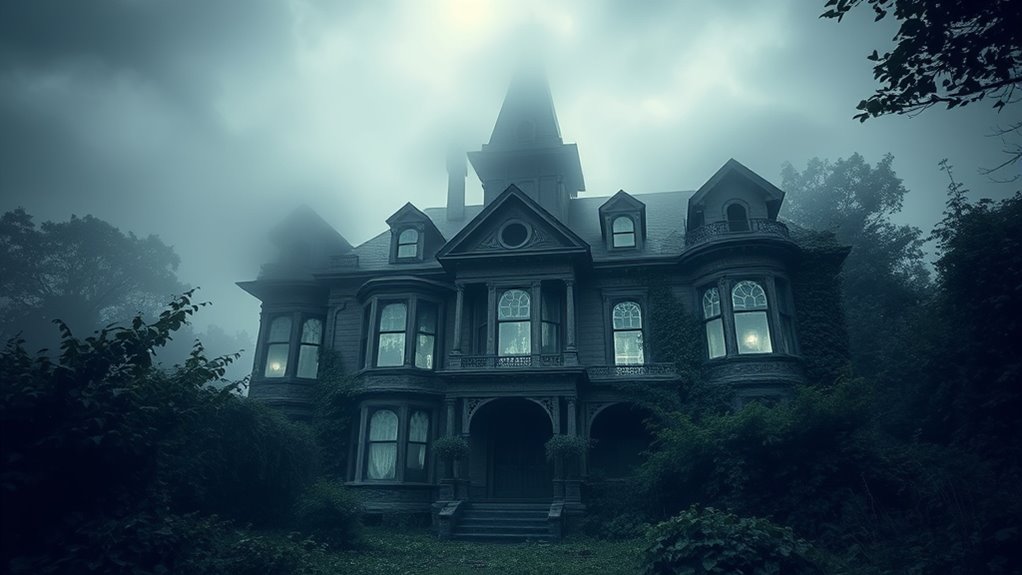
Residual energy refers to the lingering impressions of past events that can replay in a location, creating the illusion of ghostly activity. These energy remnants and emotional imprints often stay behind long after the event has ended. They can manifest as flickering lights, sounds, or even feelings that seem to echo through time. To understand this better, consider:
- Intense emotional moments leave strong imprints on a space.
- Repeated traumatic incidents reinforce energy remnants.
- Places with historical significance tend to hold more emotional imprints.
- Environmental factors can amplify residual energy, making it feel more vivid.
Unexplained Phenomena and Paranormal Activity
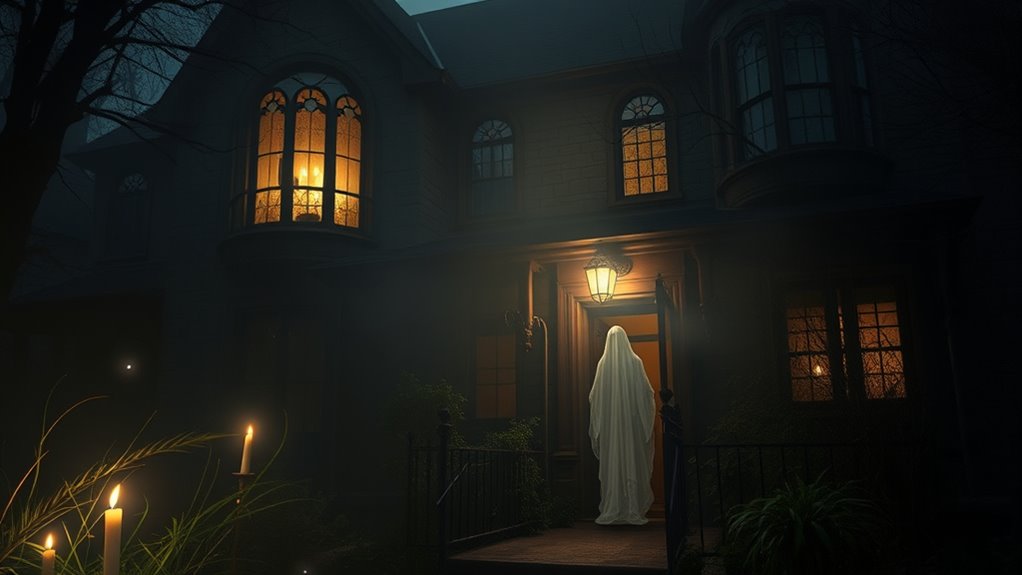
While residual energy accounts for many ghostly impressions, some phenomena go beyond simple emotional imprints and exhibit unexplained activity that defies logical explanation. You might experience quantum anomalies, where the fabric of reality seems to flicker or shift unexpectedly, suggesting disturbances in the fundamental structure of space-time. Electromagnetic disturbances are also common, causing unexplained flickering lights, electronic malfunctions, or disembodied sounds. These anomalies often occur in places with high electromagnetic activity, making it difficult to attribute the phenomena solely to emotional residue. Instead, they hint at deeper, more mysterious forces at play—forces that challenge our understanding of physics and reality. Such activity fuels the mystery of haunted locations, leaving you questioning what’s truly possible beyond the limits of science.
The Influence of Media and Popular Culture
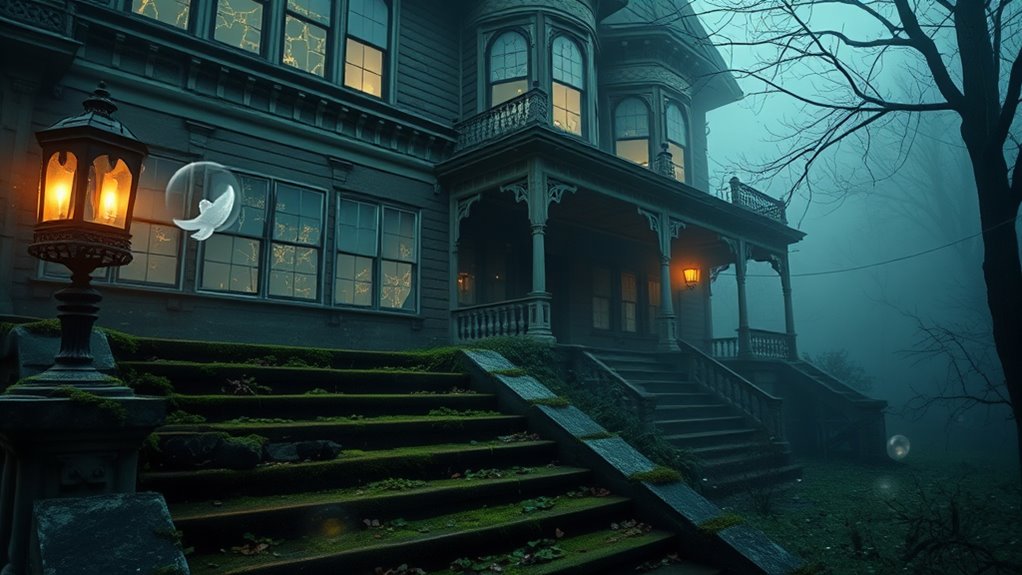
Media and popular culture shape how we see haunted hotspots, often turning local legends into national stories. Horror films and urban legends reinforce eerie narratives, making certain locations seem more haunted than they might be. This pop culture imprint influences our perceptions and keeps ghost stories alive in the public imagination. Additionally, fan communities and community tools play a role in spreading and preserving these stories, fueling the mythos surrounding these sites.
Media-Driven Haunted Narratives
Media and popular culture play a powerful role in shaping how you perceive haunted hotspots, often blending fictional stories with real-world locations. Media sensationalism amplifies fears, making certain sites seem more haunted than they truly are. Fictional storytelling fuels these perceptions, weaving ghostly tales that stick with you. To understand this influence better, consider:
- Media exaggerates events to attract viewers.
- Popular stories often blur fact and fiction.
- Haunted locations become symbols through media hype.
- Your perception is shaped by repeated narratives.
- The visual depiction of haunted sites in movies and TV shows can reinforce beliefs about their paranormal activity.
This cycle deepens your belief in haunted hotspots, even if evidence is lacking. The media’s role isn’t just to inform but to entertain, often creating an aura of mystery that keeps these sites haunting your imagination.
Horror Films & Urban Legends
Horror films and urban legends have a powerful way of shaping how you perceive haunted hotspots, often blurring the line between fiction and reality. When you see ghostly apparitions in movies or hear eerie legends about a place, your mind becomes more receptive to its haunted reputation. These stories amplify the atmosphere, making you more likely to believe in supernatural activity. Additionally, media influences can create effective strategies that reinforce these perceptions through repeated exposure.
| Media Influence | Effect on Perception |
|---|---|
| Horror movies | Heighten fear and belief in ghostly apparitions |
| Urban legends | Reinforce eerie legends and local lore |
| Popular culture | Entrench haunted hotspots in collective consciousness |
This combination fuels your perception that these places are genuinely haunted, blending entertainment with reality in your mind.
Pop Culture’s Haunted Imprint
Stories from movies, TV shows, and popular culture have cemented haunted hotspots in the collective imagination, shaping how you perceive these places beyond mere local legends. Media amplifies urban legends and folklore narratives, transforming them into iconic symbols of the supernatural. This influence can be seen in four key ways:
- It amplifies fears, making places seem more haunted than they are.
- It popularizes stories, ensuring they reach wider audiences.
- It blurs the line between fact and fiction, adding layers of myth.
- It creates a cultural imprint, making certain locations famous for their haunted reputation.
Additionally, the portrayal of these locations in best anime movies and animated films often emphasizes their haunted qualities, further reinforcing their spooky reputation in popular culture.
Environmental Conditions That Amplify Fear

Environmental conditions play a pivotal role in amplifying our fear of ghostly hotspots. Factors like climate change create unsettling atmospheres, with extreme weather and eerie silence intensifying unease. Urban decay also contributes by turning once-vibrant areas into haunting, abandoned spaces, fueling our imagination. These conditions heighten sensory inputs, making shadows seem darker and sounds more ominous. Consider the following factors:
| Environmental Element | Impact on Fear |
|---|---|
| Climate Change | Unpredictable weather, storms heighten tension |
| Urban Decay | Dilapidated buildings evoke neglect and abandonment |
| Darkness | Reduced visibility triggers suspicion and fear |
| Silence | Amplifies sounds, creating an eerie atmosphere |
Together, these elements deepen the sense of danger, making places feel more haunted than they truly are. Additionally, atmospheric effects caused by these conditions can distort perception, further fueling fear and superstition.
Personal Experiences and Subjective Encounters

Have you ever experienced a strange presence or seen an apparition that felt inexplicably real? These encounters often leave a lasting emotional impact, stirring fear, awe, or curiosity. Your senses might pick up subtle cues—cold spots, whispers, or fleeting shadows—that shape your perception of the supernatural. Sometimes, sensory perception can be influenced by our environment or mental state, affecting how we interpret these experiences.
Personal Encounters With Apparitions
Many people who claim to have experienced encounters with apparitions describe moments that feel both surreal and intensely personal. These encounters often hinge on personal intuition, guiding you to recognize something beyond the physical. Sometimes, the apparition reflects cultural symbolism, representing themes like loss, memory, or guidance. To understand your experience better, consider:
- The context of the sighting—was it tied to a specific event or location?
- The emotional response—did it evoke comfort, fear, or curiosity?
- The appearance—was it a loved one or an unknown figure?
- The symbolism—does it align with cultural beliefs or personal memories?
These elements suggest that your subconscious and cultural background influence your perception, making each encounter uniquely meaningful.
Emotional Impacts of Encounters
Encountering an apparition often stirs a powerful emotional response that stays with you long after the moment passes. You might feel an immediate shock, but the real impact comes later, as emotional trauma begins to settle in. These encounters can leave lingering fears, making you question your safety and sanity. The emotional weight can be overwhelming, creating a sense of vulnerability that’s hard to shake. Some people experience intense anxiety, nightmares, or paranoia, as their minds replay the encounter. Even if you dismiss it as imagination, the emotional imprint remains. Over time, these feelings can shape your perception of a place, intensifying its haunted reputation. Ultimately, personal encounters aren’t just fleeting moments—they leave deep, lasting emotional scars that influence how you see the world.
Sensory Experiences and Perceptions
When you experience a supposed encounter with a ghost, your senses often become heightened, blurring the line between reality and imagination. Sensory deprivation or perceptual distortion can amplify this effect, making ordinary surroundings seem extraordinary. Your mind may interpret subtle cues as supernatural signals, leading to personal experiences that feel incredibly real. Consider these factors:
- Heightened senses due to environmental cues
- Sensory deprivation intensifying perceptions
- Perceptual distortion creating illusions
- Personal biases shaping interpretations
These elements combine to make ghostly encounters feel authentic, even if your senses are deceiving you. The mind’s tendency to fill gaps with familiar fears or expectations plays a vital role. Ultimately, subjective perceptions shape how you interpret these uncanny moments.
Scientific Explanations and Skeptical Perspectives

Scientific explanations often attribute ghostly hotspots to natural phenomena rather than paranormal activity. Quantum anomalies are one possible cause, where irregularities in quantum fields might produce strange sensations or perceptions. Electromagnetic interference is another common factor; fluctuations in electromagnetic fields can distort sensory input or create hallucinations, making environments feel haunted. Devices like EMF meters often detect unusual signals near reported hotspots, supporting skeptical views. These phenomena can affect your brain’s perception, causing feelings of unease or hallucinations without any supernatural cause. While some claim these spots are haunted, scientific perspectives suggest that natural, measurable factors—such as electromagnetic interference and quantum anomalies—are responsible for many ghostly experiences. Understanding these mechanisms helps demystify these eerie sensations.
Frequently Asked Questions
Can Geographical Features Influence Haunted Locations?
Geographical features definitely influence haunted locations. You might notice that geological formations like caves or abandoned mines create eerie atmospheres, fueling spooky stories. Climatic conditions, such as foggy or stormy weather, heighten the sense of mystery and fear. These features can make places feel more haunted because they affect how environments look and feel, intensifying your emotional and psychological reactions to supposed paranormal activity.
How Do Local Legends Shape Ghostly Reputations?
You can see how local legends shape ghostly reputations by fueling the mystery and fear around a place. Legendary stories, passed down through generations, embed cultural beliefs that make certain sites seem haunted. When you hear these tales, they influence your perception and heighten your sense of the supernatural, even if there’s no real evidence. These stories create a lasting impression, turning ordinary locations into eerie, haunted spots in your mind.
Are Certain Times of Year More Haunted Than Others?
Imagine a foggy October night—seasonal phenomena like this often make certain times of year feel more haunted. You’ll notice holiday hauntings spike around Halloween, when spooky stories and eerie traditions heighten the atmosphere. These moments tap into collective fears, amplifying ghostly activity. So, yes, some times of year genuinely seem more haunted because of these seasonal phenomena, making your ghostly encounters feel even more real during certain seasons.
Do Personal Backgrounds Affect Ghost Perceptions?
Your personal background greatly influences how you perceive ghosts. Personal biases and cultural influences shape your beliefs and expectations about the paranormal. If you grow up in a culture that emphasizes spirits and hauntings, you’re more likely to interpret unexplained events as ghostly encounters. Conversely, skepticism or different cultural views might lead you to dismiss or overlook potential paranormal signs. Your unique experiences and background play a key role in how you perceive the haunted.
Can Environmental Changes Reduce Paranormal Activity?
Environmental changes like climate shifts and urban development can influence paranormal activity perceptions. You might notice fewer ghostly sensations if these changes reduce old structures or alter the atmosphere that fuels haunting stories. Urban development can also diminish natural energies linked to hauntings, making locations feel less haunted. While not guaranteed, changing the environment can sometimes lessen the feeling of paranormal presence and create a different sense of space altogether.
Conclusion
So, next time you feel that chill or hear a strange noise, ask yourself: is it really a ghost, or just your mind playing tricks? Haunted places tap into our fears, memories, and environment, blurring the line between reality and imagination. Whether you believe in spirits or not, understanding these factors helps you see why some spots just feel… different. After all, isn’t the mystery part of what makes these places so intriguingly haunting?
